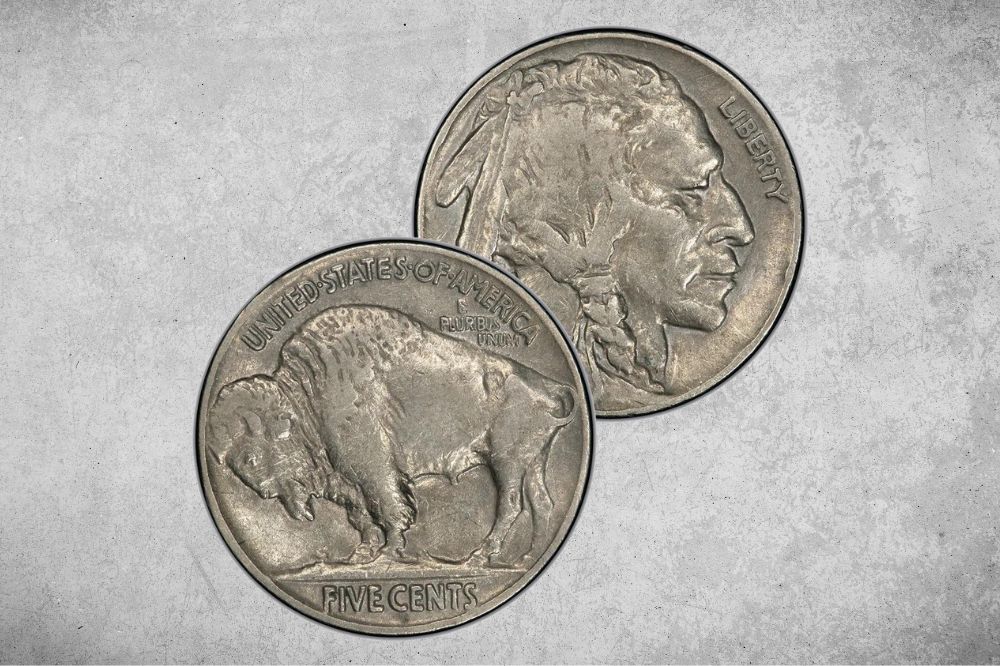Are you curious about the value of a 1936 Buffalo nickel? This iconic coin, featuring the profile of a Native American on one side and a buffalo on the other, has been a favorite among collectors for decades.
Today, we’ll explore the factors that determine the value of a 1936 Buffalo nickel, including its condition and mintmark.
So, whether you’re a seasoned collector or just starting out, this 1936 Buffalo Nickel value guide will provide a helpful overview of what to look for when assessing the coin. Let’s dive right in!
1936 Buffalo Nickel Value Details

- Category: Buffalo Nickel
- Mint: Philadelphia, Denver, and San Francisco
- Mintage: 158,741,000
- Obverse Designer: James Earle Fraser
- Reverse Designer: James Earle Fraser
- Composition: 75% copper and 25% nickel
- Diameter: 21.2 mm
- Thickness: 1.95 mm
- Weight: 5g
Also Read: 15 Most Valuable Nickels Worth Money
1936 Buffalo Nickel Value Chart
| Mint Mark | Good | Extremely Fine | MS-60 | MS-67+ |
| 1936 (P) No Mint Mark Buffalo Nickel Value | $1.14 | $3 to $6 | $22 | $525+ |
| 1936 “D” Mint Mark Buffalo Nickel Value | $1.13 | $4 to $6 | $35 | $1,500+ |
| 1936 “S” Mint Mark Buffalo Nickel Value | $1.13 | $4 to $6 | $37 | $6,000+ |
1936 Buffalo Nickel Value and Varieties
1936 (P) No Mint Mark Buffalo Nickel Value
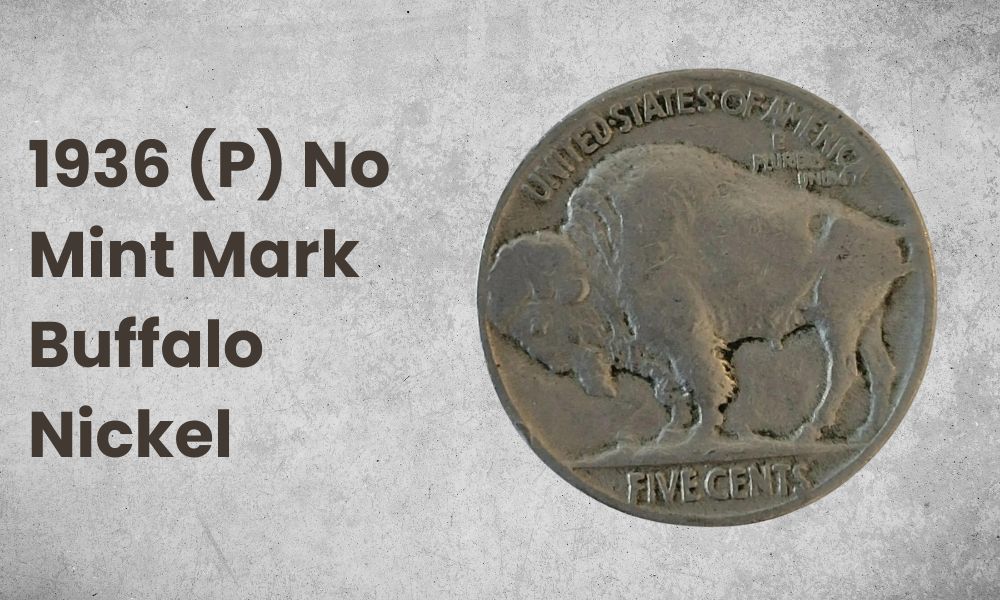
- Type: Buffalo Nickel
- Edge: Plain
- Mint Mark: None
- Place of Minting: Philadelphia
- Year of Minting: 1936
- Face Value: $0.05
- $ Price: $1 to $525+
- Quantity Produced: 118,997,000
- Designer: James Earle Fraser
- Composition: 75% copper and 25% nickel
- Mass: 5g
- Diameter: 21.2mm
1936 (P) No Mint Mark Buffalo Nickel was minted in massive quantities (over 118 million) at the Philadelphia mint. So, it is very easy to find its specimens today.
What sets 1936 (P) No Mint Mark Buffalo Nickel apart is the absence of a mint mark on its surface due to a policy implemented by the United States Mint in 1838 to discourage counterfeiters from producing fake coins with the Philadelphia Mint’s mint mark.
While the easy availability of the coin may make it less desirable amongst collectors, the coin’s condition can significantly impact its value. The coin is graded on the standard scale of 1 to 70, with higher grades indicating better condition and greater value.
On average, a circulated 1936 No Mint Mark Buffalo Nickel is worth $1 to $1.14 in good condition. If you look at coins in extremely fine condition, the value rises from $3 to $6. However, the actual demand is for uncirculated coins.
These coins are well-maintained with little to no surface damage. At higher grades, the coins may also retain some of their original shine. You can expect their values to be between hundreds and thousands of dollars.
For example, NGC sold a 1936 No Mint Mark Buffalo Nickel (MS-67) coin for $525 in 2021. It also auctioned an MS-68 coin for $16,500 the same year!
1936 “D” Mint Mark Buffalo Nickel Value

- Type: Buffalo Nickel
- Edge: Plain
- Mint Mark: D
- Place of Minting: Denver
- Year of Minting: 1936
- Face Value: $0.05
- $ Price: $1 to $1,500+
- Quantity Produced: 24,814,000
- Designer: James Earle Fraser
- Composition: 75% copper and 25% nickel
- Mass: 5g
- Diameter: 21.2mm
The Denver Mint produced over 24 million 1936 D, Buffalo Nickels, making it one of the more common Buffalo Nickels from that year. Despite its relative abundance, it is still a sought-after coin among collectors due to its unique design and historical significance.
A well-circulated coin in good condition is worth between $1 to $1.13. In extremely fine condition, the coin has less flattened areas and more clearly visible details. Collectors on a budget can get it for $4 to $6.
They are easily available on e-commerce sites like eBay and Etsy. However, it’s best to purchase your first few specimens at auctions and physical shops. This will give you a better experience in identifying genuine coins.
A 1936 D Buffalo Nickel coin in uncirculated condition is more valuable than that. At MS-60, you will find the coin for around $35. But, at MS-67, the worth of a single 1936 D Buffalo Nickel hikes up to $1,500.
If you think that’s expensive, you would be surprised to know that the highest-grade specimen evaluated by NGC is MS-68. This coin had the finest surface with original well-preserved high-relief areas and original shine. It was auctioned for a whopping $30,000 in 2021!
1936 “S” Mint Mark Buffalo Nickel Value
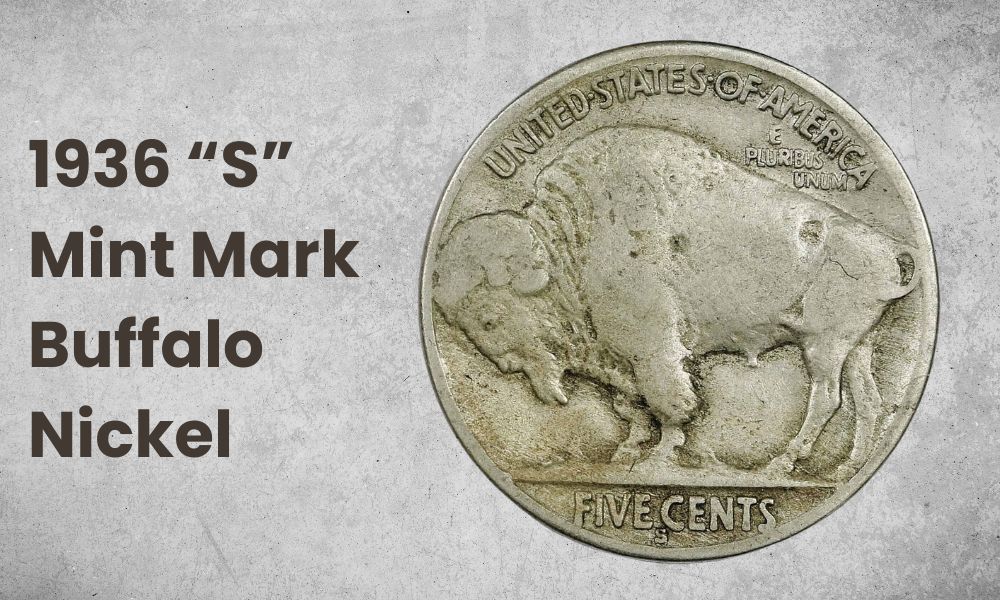
- Type: Buffalo Nickel
- Edge: Plain
- Mint Mark: S
- Place of Minting: San Francisco
- Year of Minting: 1936
- Face Value: $005
- $ Price: $1 to $6,000+
- Quantity Produced: 14,930,000
- Designer: James Earle Fraser
- Composition: 75% copper and 25% nickel
- Mass: 5g
- Diameter: 21.2mm
The San Francisco Mint’s production of the 1936 Buffalo Nickel was relatively small, making it a particularly desirable coin among collectors. The reason for the low mintage can be attributed to several factors.
Firstly, the Great Depression had a significant impact on the economy, leading to a decrease in demand for coins. Additionally, the San Francisco Mint was focused on producing other denominations, such as silver dollars, during this time.
The rarity of the 1936 S Mint Mark Buffalo Nickel has made it a highly sought-after coin in the Buffalo Nickel series.
Depending on its condition, a 1936 S Mint Mark Buffalo Nickel’s worth changes. Higher grades fetch higher prices, whereas low-circulated grades sell for a few dollars. A coin in good condition is valued at $1 or more.
In extremely fine condition, the worth rises to $4 and $6 for a single specimen. However, as with the rest of the varieties, uncirculated coins can be valued at several hundred dollars.
For example, an MS-66 1936 S Mint Mark Buffalo Nickel sells for $200+. A coin with an MS-67 grade has a worth between $1,500 to $6,000. You can get even higher figures at auctions and exhibitions.
Collectors should also be mindful of any potential flaws or variations that could significantly boost the coin’s value.
Also Read: Top 110 Most Valuable Nickels Worth Money
1936 Buffalo Nickel History
The 1936 Buffalo Nickel is a coin that holds a special place in American coin collecting history. It was minted during a time of economic hardship and political change, and its design and production reflect the issues of the era.
Commonly referred to as the Indian Head Nickel, the Buffalo Nickel was first introduced in 1913. It featured a Native American chief on the obverse and a buffalo on the reverse. The design was the work of sculptor James Earle Fraser, who was inspired by the American West and the culture of the Native American tribes that lived there.
The coin quickly became popular with the American public, who appreciated its unique design and the fact that it was made from a combination of copper and nickel rather than traditional silver.
The 1936 Buffalo Nickel was produced at three different mints: Philadelphia, Denver, and San Francisco. The Philadelphia Mint did not use a mint mark, while the Denver and San Francisco Mints used a “D” and an “S,” respectively.
The Denver Mint produced over 24 million of these coins in 1936, making it one of the more common Buffalo Nickels from that year. On the other hand, the San Francisco Mint only produced a little over 14 million coins, making it one of the scarcer coins in the Buffalo Nickel series.
This low mintage of the 1936 S Mint Mark Buffalo Nickel was due to decreased demand for the coin and the economic conditions of the time. The Great Depression significantly impacted the United States, and many people struggled financially.
The 1936 Buffalo Nickel also had political significance. In 1933, President Franklin D. Roosevelt published an executive order that required all coins to be redesigned to reflect the country’s changing values.
It was among the coins that were affected by this order, and the design was modified slightly in 1936 to include the addition of the word “CENTS” on the reverse. This was done to prevent counterfeiters from removing the buffalo design and passing off the coin as a higher denomination.
1936 Buffalo Nickel Grading
Grading is a crucial element in determining the value of a 1936 Buffalo Nickel. Collectors’ commonly used grading scale spans from 1 to 70. MS-70 represents a flawless coin.
Coins with a grade of MS-60 or higher are considered in mint state condition. This means that they were never put into circulation and had no signs of wear. Such coins can command a premium price.
Coins with a lower grade may have varying degrees of wear and damage, which decreases their value. The coin’s condition can also be affected by factors such as cleaning, scratches, or dents.
To learn more about the 1936 Buffalo Nickel grading, watch this video!
List of 1936 Buffalo Nickel Errors
1. 1936 Buffalo Nickel Double Die
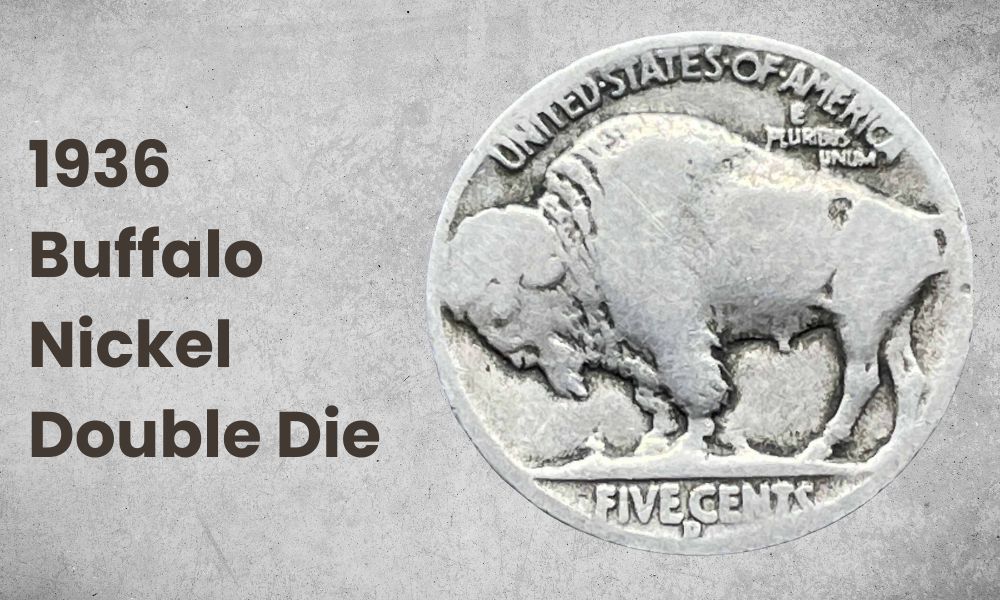
A double die error occurs during the minting process when the coin is struck two times. The second strike is often misaligned, which creates a ghost image.
This error is relatively common, but the number of double die errors discovered on 1936 Buffalo Nickels is small. Based on the exact coin’s condition and the degree of the defect, the value of a 1936 Buffalo Nickel with a double die error can vary significantly.
For instance, a 1936 Buffalo Nickel in mint shape (MS-60 or better) with a major double die error may yield thousands of dollars. A coin with a less serious defect or in worse condition, though, can be worth considerably less.
2. 1936 Buffalo Nickel Off-Centre Strike
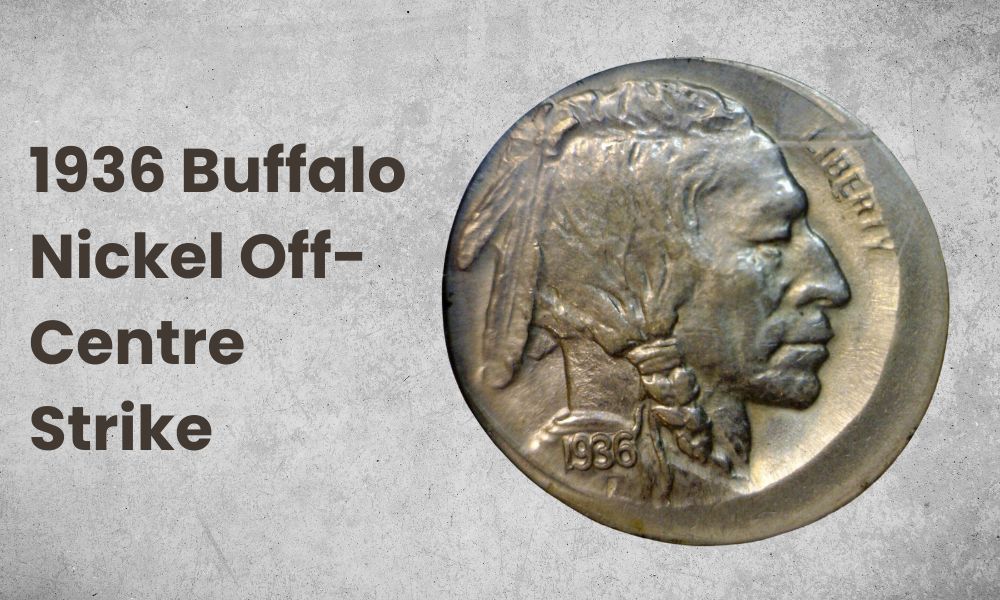
The off-center strike is a common error during coin production. It causes the image to be misaligned or the design to appear incomplete.
The degree of off-centering can vary, with some coins displaying a partial design and some only having minor issues. In general, a coin’s value can improve with an off-center strike of between 5 and 10%. Certain 1936 Buffalo Nickel coins with a severely off-center striking can scoop up hundreds or even thousands of dollars in the open market.
3. 1936 Buffalo Nickel Clipped Planchet

A clipped planchet error is caused by a mistake in the cutting process where a portion of the coin’s edge is missing or incomplete. This can occur either before or after the striking process, resulting in a partial or full clip.
As a general principle, a 1936 Buffalo Nickel in fine condition with a half clip is worth a few dollars, while a full clip might raise the value to somewhere between $50 and $100.
The precise value, however, can change depending on the unique qualities of the coin and market demand at the moment it is offered for sale.
4. 1936 Buffalo Nickel Lamination Error
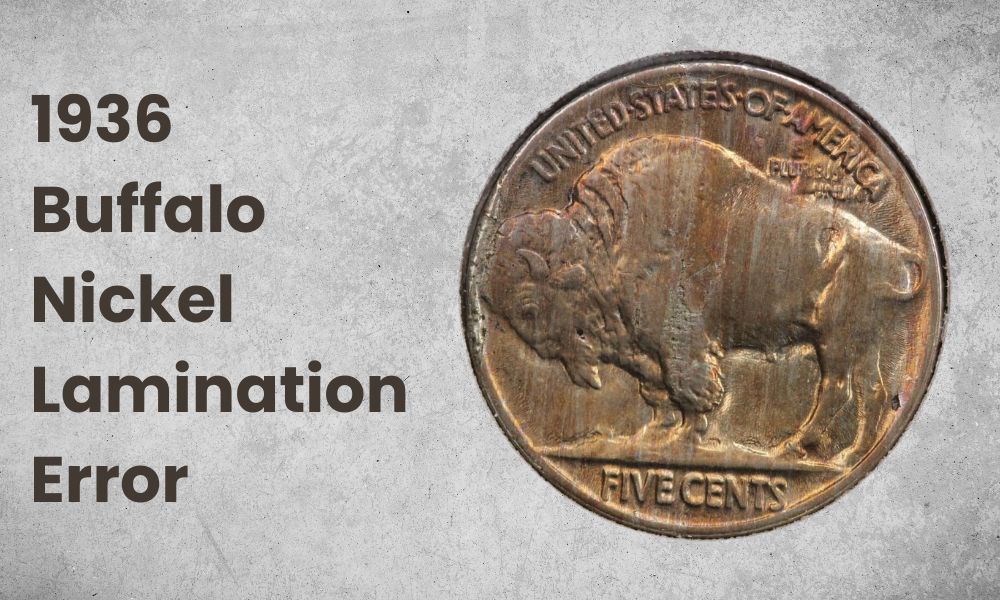
Lamination error occurs when the layers of the coin’s surface split and separate. This results in a peeled effect.
Compared to a coin with a less obvious or off-center lamination defect, a 1936 buffalo nickel with a prominent and centered lamination error in uncirculated condition can be valued at hundreds of dollars or more.
5. 1936 Buffalo Nickel Die Cracks
Die cracks occur when the die used to strike the coin develops a crack or fracture, resulting in a visible line on the coin’s surface.
The crack can occur in various parts of the die and create different coin patterns. These patterns can include a simple line, a web-like pattern, or even a break in the design.
Die cracks on a 1936 Buffalo Nickel will affect its value depending on where they are, how big they are, and how severe they are. Small die cracks may not have a substantial impact on the coin’s value, but major cracks that obscure the design or writing may.
A 1936 Buffalo Nickel with a less obvious die fracture is often valued in the hundreds, though coins with more obvious cracks can sell for thousands of dollars or more in superb condition.
1936 Buffalo Nickel FAQs
What makes a 1936 Buffalo Nickel valuable?
Several factors can make a 1936 Buffalo Nickel valuable, including its condition, rarity, mint mark, and any errors or varieties it may have.
High-grade, uncirculated coins with a sharp strike and no significant damage are typically more valuable. The 1936 S Mint Mark Buffalo Nickel is rarer and more valuable than the 1936 D and 1936 Philadelphia issues.
Additionally, any errors, such as the Double Die, can significantly increase the value of the coin.
How do I know if my Buffalo Nickel is rare?
The rarity of a Buffalo Nickel depends on various factors, such as the year of minting, the mint mark, and any errors or variations. To determine if your Buffalo Nickel is rare, you can consult a coin guidebook or have it appraised by a professional coin dealer.
